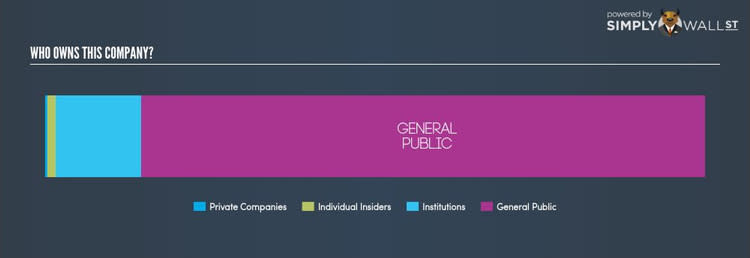Who Are The Major Shareholders Of Rose Petroleum plc (AIM:ROSE)?

I am going to take a deep dive into Rose Petroleum plc’s (AIM:ROSE) most recent ownership structure, not a frequent subject of discussion among individual investors. The impact of a company’s ownership structure affects both its short- and long-term performance. Since the effect of an active institutional investor with a similar ownership as a passive pension-fund can be vastly different on a company’s corporate governance and accountability of shareholders, investors should take a closer look at XYZ’s shareholder registry. All data provided is as of the most recent financial year end.
View our latest analysis for Rose Petroleum
Institutional Ownership
With an institutional ownership of 13.06%, ROSE can face volatile stock price movements if institutions execute block trades on the open market, more so, when there are relatively small amounts of shares available on the market to trade Although ROSE has a high institutional ownership, such stock moves, in the short-term, are more commonly linked to a particular type of active institutional investors – hedge funds. For shareholders in ROSE, sharp price movements may not be a major concern as the primarily active ones, hedge funds, hardly hold a mentionable stake in the company. Although this doesn’t necessarily lead to high short-term volatility, we should dig deeper into ROSE’s ownership structure to find how the remaining owner types can affect its investment profile.
Insider Ownership
I find insiders are another important group of stakeholders, who are directly involved in making key decisions related to the use of capital. In essence, insider ownership is more about the alignment of shareholders’ interests with the management. Although individuals in ROSE hold only a 1.15% stake, it’s a good sign for shareholders as the company’s executives and directors have their incentives directly linked to the company’s performance. It would also be interesting to check what insiders have been doing with their shareholding recently. Insider buying can be a positive indicator of future performance, but a selling decision can be simply driven by personal financial requirements.
General Public Ownership
A big stake of 85.29% in ROSE is held by the general public. This size of ownership gives retail investors collective power in deciding on major policy decisions such as executive compensation, appointment of directors and acquisitions of businesses. Such level of ownership gives retail investors the power to sway key policy decisions such as board composition, executive compensation, and potential acquisitions. This is a positive sign for an investor who wants to be involved in key decision-making of the company.
Private Company Ownership
Potential investors in ROSE should also look at another important group of investors: private companies, with a stake of 0.49%, who are primarily invested because of strategic and capital gain interests. However, an ownership of this size may be relatively insignificant, meaning that these shareholders may not have the potential to influence ROSE’s business strategy. Thus, investors not need to worry too much about the consequences of these holdings.
What this means for you:
Are you a shareholder? The company’s high institutional ownership makes margin of safety a very important consideration to existing investors since long bull and bear trends often emerge when these big-ticket investors see a change in long-term potential of the company. This is to avoid getting trapped in a sustained sell-off that is often observed in stocks with this level of institutional participation. If you’re looking to diversify your holdings with high-quality stocks, our free analysis platform has a selection of high-quality stocks with a strong growth potential.
Are you a potential investor? If you are building an investment case for ROSE, ownership structure alone should not dictate your decision to buy or sell the stock. Rather, you should be looking at fundamental drivers like the future growth expectations around ROSE, which is a key factor that will influence ROSE’s share value. Take a look at our most recent infographic report on ROSE for a more in-depth analysis of these factors to help you make a more well-informed investment decision.
NB: Figures in this article are calculated using data from the last twelve months, which refer to the 12-month period ending on the last date of the month the financial statement is dated. This may not be consistent with full year annual report figures.
To help readers see pass the short term volatility of the financial market, we aim to bring you a long-term focused research analysis purely driven by fundamental data. Note that our analysis does not factor in the latest price sensitive company announcements.
The author is an independent contributor and at the time of publication had no position in the stocks mentioned.

